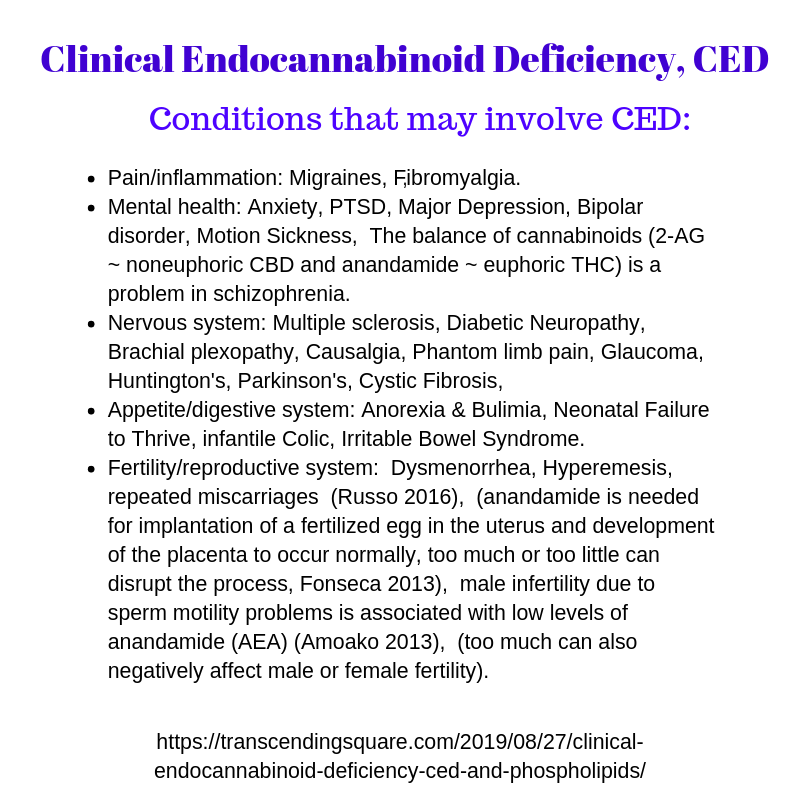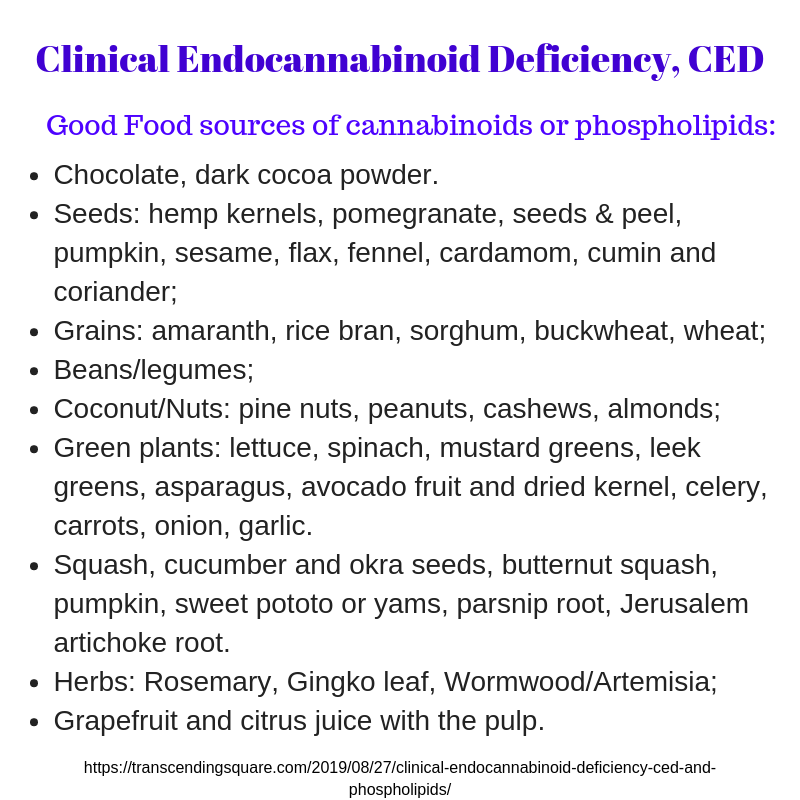During normal health we make cannabinoids internally – endogenously, hence the term endocannabinoids in contrast to cannabinoids found in plants such as cannabis/marijuana/hemp. Most cannabinoids do not cause euphoria even though the group may be best known for that affect.
Anandamide (AEA) is the endocannbinoid that is chemically similar to the euphoria causing cannabinoid found in marijuana known as THC, tetrahydrocannabinol. Cannabidiol, CBD, is a non-euphoria causing cannabinoid found in some strains of marijuana. It is chemically similar to the endocannabinoid known as 2-AG which in times of normal health is found in greater concentration within the body than anandamide.
Cannabinoids within the body are found as a structural part of cell membranes. They also can be released from the membranes and used as signaling chemicals within the brain and peripheral nerves, affecting many things including memory, appetite, sleep, movement, and fertility. The cannabinoids when released from the cell membranes can also be modified into another type of signaling chemical that is important in immune health (eicosanoids).
Due to genetic changes or other issues with metabolism or health some people may not be able to make cannabinoids internally and would need an external source to maintain health. Due to marijuana having been listed as a controlled substance considered to have no medicinal value research has been limited to studies about toxicity and addiction. Research on the role cannabinoids plays in health is becoming more available but is still in early stages considering the many functions they have within the brain and body.
Conditions that may involve Clinical Endocannabinoid Deficiency, (CED):
Conditions that may involve a deficiency in cannabinoids chronically may include symptoms of pain, muscle spasms, nerve numbness, mood disorders, movement disorders, digestive and appetite problems, appetite and growth failure in infants or colic, menstrual problems and infertility/miscarriages and hyperemesis prenatally.
- Pain/inflammation: Migraines, Fibromyalgia.
- Mental health: Anxiety, PTSD, Major Depression, Bipolar disorder, Motion Sickness, The balance of cannabinoids (2-AG ~ noneuphoric CBD and anandamide ~ euphoric THC) is a problem in schizophrenia. There is too much of the anandamide, excess THC can cause schizophrenia like symptoms, and providing CBD may help patients. *See this post for more nutritional deficiencies that cause schizophrenia like symptoms, five or more may be involved, suggesting the problem is a symptom rather than a condition with a single cause – and a single cure: The voices that people with schizophrenia are hearing are probably their own inner thoughts.
- Nervous system: Multiple sclerosis, Diabetic Neuropathy, Brachial plexopathy, Causalgia, Phantom limb pain, Glaucoma, Huntington’s, Parkinson’s, Cystic Fibrosis,
- Appetite/digestive system: Anorexia & Bulimia, Neonatal Failure to Thrive, infantile Colic, Irritable Bowel Syndrome.
- Fertility/reproductive system: Dysmenorrhea, Hyperemesis, repeated miscarriages (Russo 2016), (anandamide is needed for implantation of a fertilized egg in the uterus and development of the placenta to occur normally, too much or too little can disrupt the process, Fonseca 2013), male infertility due to sperm motility problems is associated with low levels of anandamide (AEA) (Amoako 2013), (too much can also negatively affect male or female fertility). *See this post for more details about infertility and phospholipids: (Phospholipid or phosphorylation deficiency: Potential symptoms)
- Other food sources of cannabinoids exist in addition to marijuana or hemp however the amount provided is in lower concentrations so you might need a large salad that includes several sources at one meal, and other sources in beverages, supplements, or at other meals.

Food sources of cannabinoids or phospholipids (a precursor chemical):
Cannabinoids, can be found in smaller amounts in foods than in medical marijuana or synthetic THC medications. Good sources include:
- Chocolate, dark cocoa powder.
- Seeds: hemp kernels, pomegranate, seeds & peel, pumpkin, sesame, flax, fennel, cardamom, cumin and coriander;
- Grains: amaranth, rice bran, sorghum, buckwheat, wheat;
- Beans/legumes;
- Coconut/Nuts: pine nuts, peanuts, cashews, almonds;
- Green plants: lettuce, spinach, mustard greens, leek greens, asparagus, avocado fruit and dried kernel, celery, carrots, onion, garlic. Squash, cucumber and okra seeds, butternut squash, pumpkin, sweet pototo or yams, parsnip root, Jerusalem artichoke root.
- Herbs: Rosemary, Gingko leaf, Wormwood/Artemisia;
- Grapefruit and citrus juice with the pulp.

Disclaimer: This information is provided for educational purposes within the guidelines of Fair Use. It is not intended to provide individual guidance. Please seek a health care provider for individualized health care guidance.




